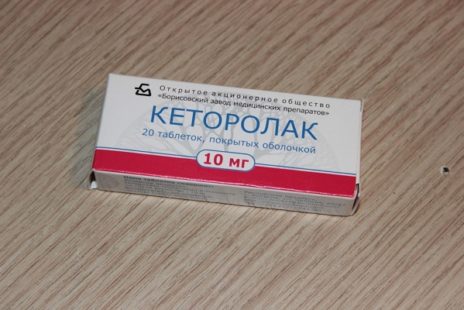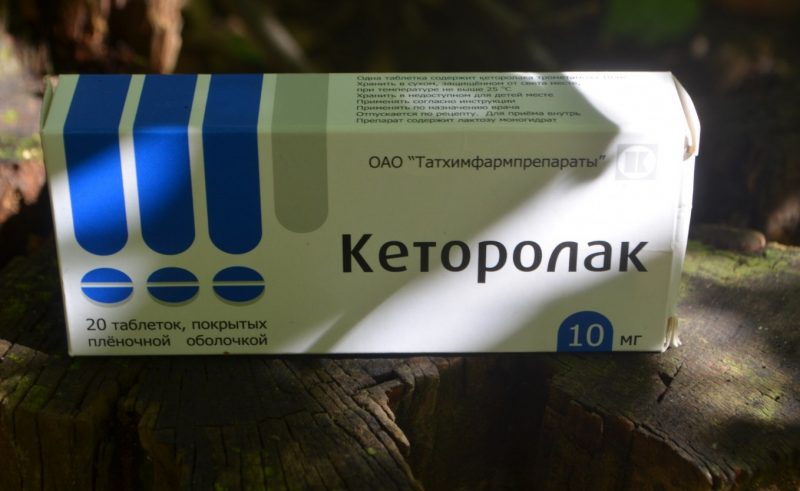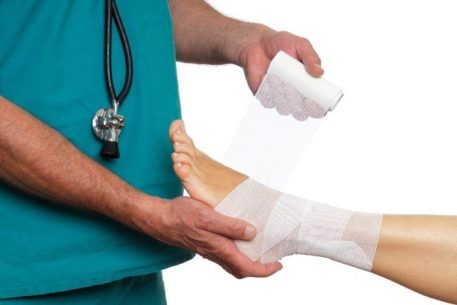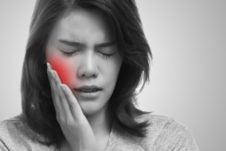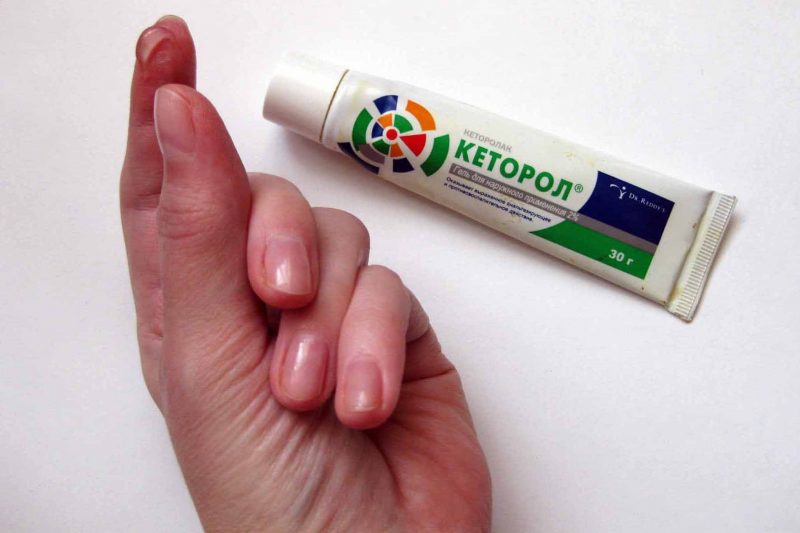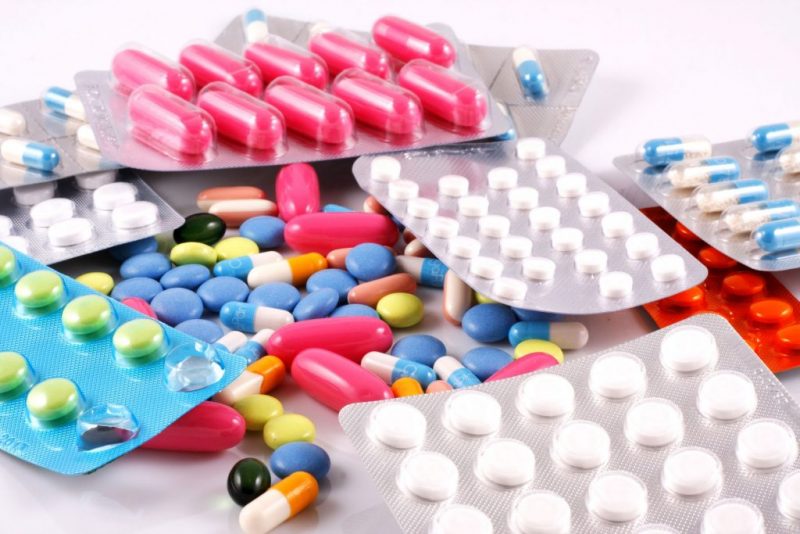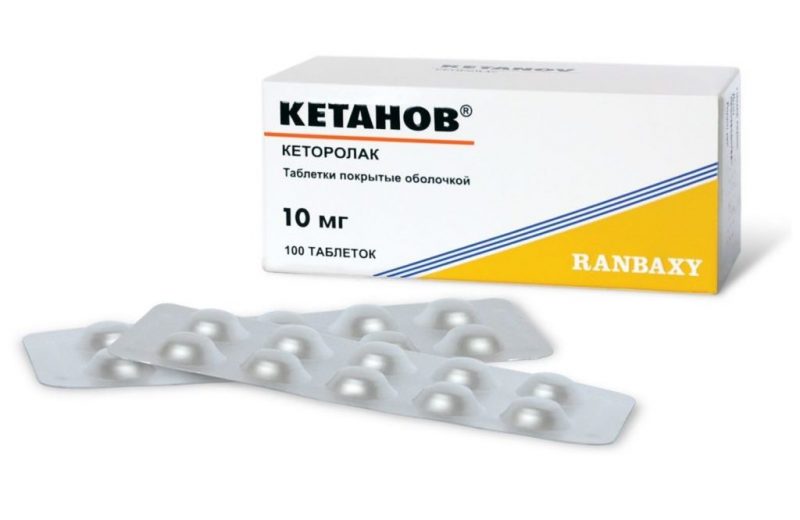Ketorolac is a highly effective, non-narcotic drug with significant analgesic effect, and related to non-hormonal drugs with anti-inflammatory activity. Additionally reduces fever and prevents the formation of blood clots.
Material Content:
Release forms and composition
The drug is produced in four pharmacological forms. The main therapeutic substance present in all pharmaceutical forms is ketorolac tromethamine (trometamol).
Forms of medication:
- White round convex tablets in a shell, placed in cell blisters of 10 units, with the content of the therapeutic substance - 10 mg in one tablet.
- Ketorol external colorless gel for topical application with a concentration of the therapeutic substance of 2%, that is, 20 mg of ketorolac is present in 1 gram of gel. It is packaged in aluminum tubes of 30 grams.
- Light yellow transparent solution for injections into the muscle and vein in ampoules of 1 ml, which contains 30 mg of the therapeutic component. In the contour blister there are 5 ampoules.
- Eye drops with a concentration of the active substance of 0.1 or 0.5%.
All medical formats of the drug are packed in a cardboard box with attached medical instructions.
Pharmacological action, pharmacodynamics and pharmacokinetics
Therapeutic properties
The drug significantly reduces pain, suppresses inflammation and fever, by suppressing the activity of the enzyme cyclooxygenase (COX) of the first and second types, which is involved in the mechanism of development of pain, inflammatory processes and fever.
Unlike opiate analgesics, Ketorolac does not show a psychotropic effect, does not cause euphoria and drowsiness, does not inhibit the respiratory process, does not cause dependence, does not affect the tone of muscle fibers of organs.
In terms of the degree of analgesic effect, the drug is superior to most other analgesics and non-steroidal anti-inflammatory drugs, and when injected, it is comparable to codeine and morphine.
The onset of the analgesic effect after the injection is noted after half an hour, after taking the tablets - after about 45-60 minutes. The maximum analgesic effect for injection is achieved after 1-2 hours, after internal administration - after 2-3 hours. The analgesic effect remains within 4-8 hours, which is determined by the severity of the pain syndrome.
Pharmacokinetics
The bioavailability of the drug (with the use of tablets and the use of injections), that is, the amount of ketorolac that reaches the painful focus is almost 100%.
With an intramuscular injection, the absorption of the active substance occurs quickly and completely, while in plasma, 99% of ketorolac is in a protein-bound state. When taking the tablets, absorption in the digestive tract is also active and complete.
The time at which the maximum concentration of ketorolac in the blood is observed after taking the pill on an empty stomach is 40 minutes. Reception of fatty foods reduces the amount of active substance in the plasma, while the time to reach the highest concentration increases to 90-100 minutes.
The therapeutic substance passes through the placenta and into breast milk, which is due to restrictions on the use of the drug in nursing and pregnant women.
When instilling ophthalmic drops, the largest amount of ketorolac in the tissues of the visual organ is detected after about 30-60 minutes, except for the tissues of the ciliary body and iris, in which the concentration of the active substance reaches a maximum 4 hours after the introduction of the drops.
When applying the gel or instilling a solution in the form of eye drops (if the doses and treatment regimen are followed), the absorption of ketorolac into the general bloodstream is very low, so there is practically no general effect on the body.
More than half of the accepted dose of the drug is processed by liver enzymes, while the function of the organ does not affect the time of elimination of the drug, which is almost completely (91%) removed from the body with urine, and only 6% is excreted in the feces.
The elimination time of half the dose of the medication taken in patients with healthy kidneys is approximately 5 hours. In people with diseased kidneys, elderly patients, the drug lingers in the body longer. If creatinine exceeds 50 mg / l against the background of severe renal failure, the elimination half-life increases to 13-14 hours or more. Moreover, it should be borne in mind that with the help of hemodialysis, ketorolac cannot be removed from the body.
What helps Ketorolac
The medication helps to significantly reduce the power of pain, to reduce the degree of inflammation in diseases of various organs, but it should be understood that
Ketorolac does not eliminate the cause of the pathology, does not stop the progression of the disease, but only affects the severity of symptoms.
Ketorolac tablets and injections are prescribed to relieve acute and paroxysmal pain (severe and moderate), as well as chronic pain of varying degrees against the background of the following pathologies:
- malignant processes;
- pain in the joints, spine (dorsalgia);
- injuries of any nature, fractures, dislocations;
- severe toothache;
- vasculitis, rheumatic diseases;
- muscle pain;
- neuralgia of intercostal, trigeminal, occipital, sciatic nerve (sciatica), neuritis, including radiculitis;
- condition after childbirth and surgical interventions;
- phase of the maturation of the boil, carbuncle.
Since the solution for injection has an effect comparable in strength to analgesia with opiates, injections may be required in a life-threatening condition of pain shock, which can develop against the background of:
- severe burns;
- knife and bullet wounds, animal bites;
- clogging of the esophagus with a foreign body;
- electric shock;
- renal and biliary colic, ruptures of the uterus, fallopian tube, twisting of the “legs” of the cyst, perforation of the stomach with perforated ulcer (but only with firm confidence in the diagnosis so as not to “smear” the clinical picture).
Ketorol gel with topical application helps to ease or completely eliminate pain in the following pathological conditions:
- bruises, sprains, inflammation, damage to muscles, ligaments, soft tissues;
- inflammatory and dystrophic changes in the joints, in the muscles;
- rheumatic pathologies, including exacerbation of psoriatic arthritis, gout, ankylosing spondylitis,
- neurological diseases;
- inflammation of the nerves (neuritis) and vessel walls (vasculitis), mucous joint bags (bursitis), synovial membrane (synovitis), tendons (tendonitis), tissues in the elbow (epicondylitis).
What helps ketorolac in the form of eye drops?
Ophthalmic drops are prescribed:
- to reduce pain during inflammation after surgery on the cornea, cataract removal, if a foreign object enters the eye, damage to the organ of vision field of medical procedures;
- eliminate burning, itching in acute atopic conjunctivitis, soreness with photophobia.
Instructions for use and dosage
During therapy, Ketorolac is used once or repeatedly for several days, which is determined by the severity of pain.
Ketorolac solution for infusion and injection
Ketorolac injections are most often prescribed in cases in which it is necessary to urgently reduce severe pain, or if the patient is not able to take the pill, for example, with nausea, vomiting, exacerbation of peptic ulcer, spasm of the esophagus.
When prescribing a drug in solution, it is recommended to use the lowest effective dose, choosing them taking into account the intensity of pain.
If the pain is significant and can lead to pain shock, nervous exhaustion or psychosis, then opiate analgesics are prescribed simultaneously with ketorolac, but at lower dosages.
In the age group of 16 to 64 years, if the patient's weight is more than 50 kg, the standard scheme provides for the introduction of 10-30 mg of the medicine (0.3-1 ampoule) every 4-6 hours, but taking into account the fact that the maximum dose per day is not should exceed 90 mg. In extremely acute pain syndrome, a dose of 90 mg (3 ampoules) is allowed immediately.
Adults with a weight of less than 50 kg, age patients (from 65 years old) and patients with impaired renal function, for 1 time you can enter no more than 30 mg. Recommended regimen: 10–15 mg (1/3 or half an ampoule) every 6 hours, but the total amount of a therapeutic substance per day should not exceed 60 mg (2 ampoules).
All injectable dosages are calculated based on whether the patient is taking additional doses of the medicine in tablets.
The duration of injection therapy is limited to 5 days.
An injection into the muscle is done slowly and deeply, intravenous infusion is carried out for at least 15-20 seconds.
The initial dose for continuous infusion of a drug into a vein with an infusomat is 30 mg, after which the infusion rate is set to 5 mg per hour. The duration of intravenous infusion is limited to 24 hours.
Pills
A single dose for oral administration is 1 tablet (10 mg). With long-term treatment (up to 5 days), the treatment regimen provides for 2–4 single doses of 10 mg, depending on the intensity of the pain. The upper daily limit on the amount of ketorolac that a patient can receive is 40 mg.
Gel for external use
Ketorol gel is applied to the area of greatest pain on clean, dry skin with light massaging finger movements 3-4 times a day with a thin layer. A gel strip 10–20 mm long is used for 1 time.
Reapply the drug after 3.5-4 hours. To prevent absorption of the drug into the blood, it is not allowed to apply the gel volume more than recommended and increase the frequency of use.
If after 7-10 days the pain does not subside or even become stronger, you should immediately visit a specialist (surgeon, rheumatologist, phlebologist, orthopedist), taking into account the type of pathology.
It is not recommended to gel ulcerated skin areas, deep abrasions, wounds and burn surfaces with damage to the epithelium.
Do not cover areas treated with pharmaceuticals, compresses and hermetic dressings.
It is necessary to avoid getting the product on the mucous membranes of the mouth, eyes, genitals.
Ketorolac eye drops
The solution is used only locally, instilling it in the lower eyelid 1 drop up to 4 times a day to eliminate pain, burning, itching. Treatment can be carried out once or for 3-4 days (no longer).
During pregnancy and lactation
Due to the negative effects on the heart and vascular system and the high risk of obstruction of the ductus arteriosus in the embryo and fetus, Ketorolac injections and tablets are prohibited for pregnant patients (especially in the last 13 weeks before childbirth), and women in labor.
Since the therapeutic substance passes into breast milk and can affect the baby’s body, it is necessary for the nursing mother to transfer the infant to artificial mixtures during therapy.
Important! With pain shock that threatens the life of a woman awaiting delivery or breastfeeding, and the absence of a safer pain medication, the ban on the use of Ketorolac is neglected.
The gel and drops are also not used during pregnancy (especially in the last 3 months of gestation) and breastfeeding, although full studies with the participation of pregnant and lactating patients have not been conducted.
Given that the absorption of the active component into the blood through the skin and conjunctiva is extremely small, in exceptional cases, single or short-term (1-2 days) use of ophthalmic drops and gel in this group of patients is allowed (strictly with the permission of the doctor). But even this does not allow the application of gel on the skin of the mammary glands of a nursing mother.
The use of this medication can affect the childbearing function of a woman and reduce the likelihood of conception, so the drug is not advisable for patients planning a pregnancy.
Drug interaction
The simultaneous use of Ketorolac with other medicines can cause all sorts of reactions, which should be taken into account.
| Pharmacological agents | Possible effect when combined with Ketorolac |
|---|---|
| COX2 blockers, glucocorticoids (Prednisolone, Dexamethasone), calcium preparations, ethanol | risk of ulceration of the mucosa of the esophagus, stomach, intestines |
| anticoagulants, including warfarin, heparin, thrombolytics, antiplatelet agents (clopidogrel), aspirin, pentoxifylline, cephalosporin antibiotics | risk of bleeding |
| ACE enzyme blockers | risk of renal dysfunction |
| anticonvulsants (carbamazepine) | bouts of seizures (rare) |
| tranquilizers (fluoxetine, alprazolam) | hallucinations |
| nephrotoxic drugs, including paracetamol, gold preparations, methotrexate | increased toxic effects on the kidneys |
In addition, the dose of pharmaceuticals should be adjusted, taking into account that Ketorolac reduces the effect of diuretic and antihypertensive drugs, but strengthens:
- the effect of insulin and other blood sugar lowering drugs;
- hepatotoxicity of methotrexate;
- the effect of narcotic painkillers (therefore, opiate doses can be reduced);
- toxicity of lithium salts;
- blood levels of verapamil, nifedipine;
And you must also consider:
- that Probenecid (Probalan) and drugs that block renal tubular secretion (the removal of substances from the blood into the urine) increase the amount of ketorolac in plasma and prolong the time it is removed from the body.
Contraindications, side effects and overdose
Ketorolac in all forms is prohibited:
- if bronchial asthma in a patient is combined with exacerbating polyposis of the nasal cavity (or sinuses) and an allergy (rash, bronchospasm, runny nose) to non-steroidal anti-inflammatory drugs, including aspirin and drugs containing pyrazolone;
- with intolerance to ketorolac and other components of the medication;
- pregnant patients, especially in the last 13 weeks before giving birth;
- nursing mothers;
- children under 3 years (for drops), up to 12 years (for gel), up to 16 years (for injectable and tablet form of the medicine), since the safety of the medicine for this age has not been established.
Highlighted contraindications for individual dosage forms
For injections and tablets:
- hemophilia, other bleeding disorders;
- erosion and ulcers in the stomach, intestines, esophagus;
- bleeding in any organs and systems, including the brain, stomach, esophagus, intestines, or an increased risk of their development;
- hypovolemia;
- severe myocardial, renal failure (CC below 30 ml / min), liver;
- renal, hepatic pathology in progression;
- exacerbations of inflammatory intestinal pathologies (Crohn's disease, ulcerative colitis);
- diagnosed excess potassium;
- recovery after cardiac aorta bypass surgery;
- pain relief before or during extensive operations.
Particular care is required when prescribing the drug if the patient is diagnosed with the following conditions:
- bronchial asthma;
- inflammatory, infectious diseases;
- brain disorders;
- myocardial ischemia;
- diabetes;
- persistently high blood pressure;
- vascular pathologies;
- atherosclerosis;
- detected Helicobacter pylori infection;
- impaired renal function, cholecystitis, cholestasis;
- blood poisoning;
- systemic lupus erythematosus;
- alcohol and tobacco abuse;
- old and young age.
The gel can not be used in areas where there is:
- weeping dermatosis, eczema;
- purulent or open wounds and abrasions.
The tool is used after consultation with an endocrinologist and a dermatologist with exacerbation of late cutaneous porphyria.
Eye drops are contraindicated in patients:
- with postoperative complications in the eyes with corneal damage;
- with concomitant diabetes mellitus, rheumatoid arthritis,
- with pathology of the mucosa of the visual organ (including dry eye syndrome),
- at small intervals between eye operations.
The ban is introduced due to the high risk of corneal damage and the threat of visual disturbances.
Side effects are more often observed with the use of high doses and the long-term use of tablets and injections.
In 3 patients out of a hundred, the following can be observed:
- gastralgia, loose stools;
- headache, dizziness, drowsiness;
1 - 2 patients out of a hundred:
- stomatitis, gas, constipation, nausea;
- increased blood pressure;
- skin rash, purpura;
- burning at the injection site.
in 1 out of a hundred patients:
- ulceration of the mucous membrane of the stomach, intestines, esophagus, perforation of an ulcer, bleeding, pain in the epigastric region, vomiting;
- cholestasis, hepatitis, pancreatitis;
- pulmonary edema, loss of consciousness;
- acute renal failure, blood in the urine, back pain, nephritis, edema;
- visual and auditory disorders;
- aseptic meningitis;
- overexcitation, depression;
- changes in blood counts;
- bleeding, including bleeding from the nose, rectum;
- exfoliative dermatitis, urticaria, Stevens-Johnson and Lyell syndrome.
- acute anaphylactic reaction with shortness of breath, bronchospasm, swelling of the eyelids, tongue, larynx, pain behind the sternum, heavy breathing.
Side effect for the gel: itchy rashes, red blisters and spots, swelling and peeling.
It is important to consider that when gel is applied to a large area of the skin, the appearance of organically undesirable reactions characteristic of injections and tablets cannot be ruled out.
Side effects for ophthalmic drops: allergy in the form of lacrimation, eye irritation, itching, burning, swelling of the eyelids.
An overdose is possible with the uncontrolled use of ketorolac, ignoring contraindications, excessive doses. In this case, the indicated side effects of the medication arise or become stronger. You should immediately cancel the treatment, take Polysorb (adsorbent) and call an ambulance to hospitalize the patient in order to conduct full-fledged therapy for drug poisoning.
Analogues of the drug
Synonyms of a medication - that is, a medicine, with the same therapeutic component: Ketanov, Dolak, Ketokam, Akyular (eye drops).
Analogs of Ketorolac or a medication with a similar therapeutic effect, but with other active substances: Xefocam, Lornosikam, Ketonal, Ketoprofen, Etorikoksib, Arkoksia.


